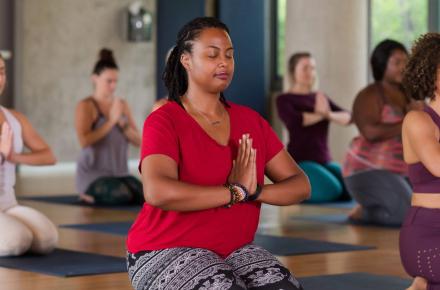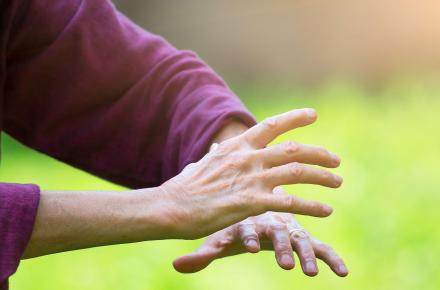Yoga for Chronic Pain and Arthritis


Acute pain, such as an ankle sprain or a slip-and-fall injury, often needs rest to heal, which may mean avoiding or modifying yoga poses. But when pain becomes chronic, as in arthritis, mind-body practices such as yoga have been shown to provide a safe supplement to medical care. In this excerpt from her book, The Science of Yoga, Kripalu presenter Ann Swanson answers frequently asked questions about how yoga addresses these conditions.
Can yoga really help when pain becomes chronic?
Yes, there is evidence to show that it can help. Pain becomes chronic when it persists beyond the healing time of about three months. If you suffer from chronic pain, such as many cases of back pain or arthritis, you generally don’t need to rest more because there may be little to no physical damage to heal. In fact, you probably need to move more because exercise tends to help relieve chronic pain, along with reducing associated stress. Yoga practices have been shown to have an analgesic—or pain-relieving—effect. In one study of military veterans with lower back pain, opioid use declined in all subjects after a 12-week, twice-weekly yoga program.
Can yoga help with arthritis?
Yes! Arthritis—the most common cause of disability in America—is also one of the most common causes of chronic pain, including back pain. A seven-year clinical trial of yoga for osteoarthritis and rheumatoid arthritis, conducted by Steffany Moonaz, PhD, C-IAYT, at Johns Hopkins University, showed that yoga is both safe and effective for arthritis. Several key findings were reduction of inflammation and a 40 percent reduction of pain.
Does meditation relieve pain because of the placebo effect?
This is a myth. Recent research has shown that mindfulness meditation works better than a placebo in reducing pain. Subjects were exposed to a painful heat stimulus before and after receiving treatment: a placebo cream, “fake meditation,” and traditional mindfulness meditation. The intensity and unpleasantness of the pain was evaluated psychophysically and by functional neuroimagery. The mindfulness group’s pain intensity and unpleasantness reduced most significantly. Four 20-minute mindfulness classes reduced pain’s unpleasantness by 57 percent.
Will asana practice reduce my chronic pain?
It depends. Some asanas can help reduce pain by stretching and strengthening the affected area(s). However, biomechanics is just one piece of the puzzle. At its most basic level, what your brain interprets as pain starts as a signal received from a receptor (nociceptor) in your body. Research has shown that the amount of pain perceived doesn’t depend on the amount of tissue damage as seen in X-ray or MRI scans. This means that without the brain, there is no pain; but this doesn’t mean pain is imagined. Your brain builds your pain experience just as it constructs your reality and perspective. The level of pain you experience is based on your brain’s interpretation of the level of danger those signals represent. So, as with chronic stress, chronic pain is partly a problem with regulation, often related to a faulty alarm system. Research shows that relaxing yoga asanas and practices, such as meditation and pranayama, can help regulate the pain response.
How much do I need to meditate to reduce pain?
Research has shown that less than 90 minutes of meditation training may help alleviate pain and diminish pain-related brain changes. (Chronic pain causes gray matter deterioration, but the areas of the brain that are degraded by chronic pain are restored during meditation through the increase of neural connections in those areas.) One study showed that just four 20-minute mindfulness classes reduced the unpleasantness of pain by 57 percent and the intensity of pain by 40 percent. It wasn’t just the perception of the pain that changed: The brain’s activity also measurably changed. The same study showed, via fMRI scans, that meditation reduced pain-related activation of the primary somatosensory cortex. Instead of a spike of activity in the area of the somatosensory cortex related to the location of the pain, researchers found that, while meditating, participants had more brain activity reflecting sensory awareness of the neck and throat, which represented the participants’ mindfulness of their breathing.
Find out about programs with Ann Swanson at Kripalu.
Text excerpted and image from Science of Yoga by Ann Swanson, reprinted by permission of DK, a division of Penguin Random House LLC. Copyright © 2019 Ann Swanson & Dorling Kindersley Limited.



















































